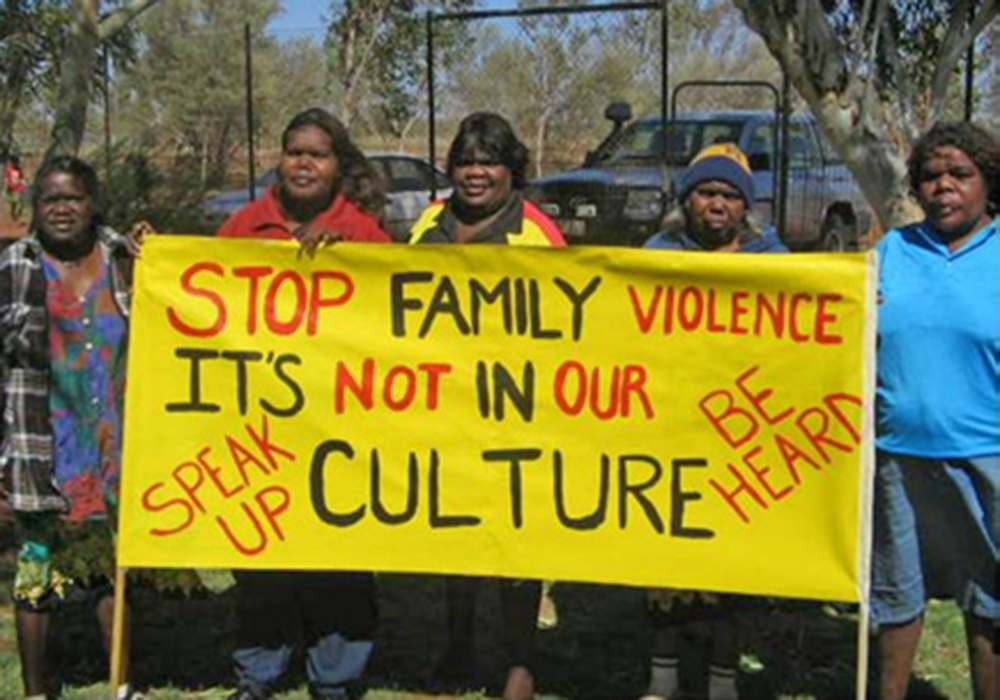The Australian government has promised a $1.1 billion health and domestic violence package to help protect vulnerable Australians during the COVID-19 crisis. But one of the most vulnerable groups of all, Aboriginal women and their children, may see little benefit at all.
Recent cuts to critical Aboriginal family violence services mean support for Aboriginal women and children vulnerable to domestic violence was already going backwards before the government’s latest promises.
New restrictions and social distancing also pose a unique challenge to the Aboriginal community-controlled sector, community health, social and family services that are relied on by Aboriginal women for family violence support.

Social distancing poses a unique pressure to Aboriginal women and children.
Aboriginal women and children are significantly over-represented in all domestic and family violence statistics. Aboriginal women are 32 times as likely to be hospitalised due to family violence as non-Aboriginal women. Aboriginal children are seven times as likely to be the subject of substantiated child protection notifications, often due to family violence.
These higher risks are exacerbated during times of crisis and high stress, like now.
With so many intersecting issues, the psychological impact of quarantine and lockdown measures will be significant.
Even without COVID19 Aboriginal families face additional stressors like overcrowded housing, inequitable health care access, trauma and racism. With so many intersecting issues, the psychological impact of quarantine and lockdown measures will be significant.
The National Aboriginal Community Controlled Health Organisation mobilised early to protect Aboriginal communities from COVID-19 and has worked hard to establish with the government an emergency response management plan to ensure an adequate response to the virus itself and its broader health impacts. But recent advice from the Australian Indigenous Doctors Association (AIDA) suggests that Aboriginal people continue to face racism in the health system when seeking COVID-19 testing and treatment.
The child, family and social services sector has been less co-ordinated and there has been little to no specific response from the COAG Women’s Safety Council regarding Aboriginal women’s and children’s safety during this time.
People in remote areas are at risk of being cut off from important support.

People in remote areas are at risk of being cut off from important support.
The burden has once again fallen to the Aboriginal community-controlled sector which is responding within its limited available resources, mobilising its community structures and relying on social media to reach out to Aboriginal women.
With such a distracted health system and the ‘usual’ barriers still impacting upon access to care for Aboriginal people, Aboriginal women’s voices and needs risk once again being unheard.
As remote Aboriginal communities close their borders, critical supports for women experiencing violence risk being cut-off or significantly reduced.
As remote Aboriginal communities close their borders and urban communities cope with lockdowns and move into crisis response mode, critical supports for Aboriginal women experiencing violence risk being either cut-off or significantly reduced due to inadequate resourcing.
Aboriginal women experiencing violence also rely heavily on their protective kinship relationships with other Aboriginal women. With social interaction currently limited to two people, COVID-19 measures will heavily impact upon both the formal and informal collective gatherings that Aboriginal women use for support.
Governments must therefore be proactive and provide specific financial and bespoke workforce support to leading Aboriginal health, social and family violence services to develop revolutionary, culturally-framed and safe mechanisms for Aboriginal women to seek the support they require.

Safe housing and community-based support systems are critical.
Social media and technology is offering women some of the support they need and holds great potential in times such as these. This is one avenue of support for Aboriginal women if set up to support safety. Safe housing, appropriate legislation changes and community-based systems of reaching women and children whilst they are in lockdown are also critical.
The onus is on government to ensure the needs of at-risk Aboriginal women and children aren’t forgotten amid the COVID-19 crisis.
Listening to those working on the front line and across the sector is critical, as is listening to the voices of many Aboriginal women who are currently in desperate need of a government that responds to their needs.
Time is running out for mobilising support for one of Australia’s most vulnerable groups.
The COVID-19 pandemic shouldn’t be remembered as the time during which governments failed to act and unprecedented numbers of Aboriginal women suffered at the hands of their violent partners or that the rates of Aboriginal children in out-of-home care soared even higher than the current alarming rate.
Time is running out for mobilising support for one of Australia’s most vulnerable groups.
Aboriginal women who live with violence show great resilience and agency day in, day out. In their mothering role, they work tirelessly to protect their children which includes mitigating the risk from both a violent partner and a violent child welfare system that often seeks to remove their children.
Aboriginal mothers need, now more than ever, opportunities to connect with trusted friends and family, help with safety plans, support for their children and ways to communicate safely.
In this context Aboriginal women generally have few supports, and the critical supports they do have are now at risk of being inaccessible or over-burdened.
Now is the time for governments to step up.
This article was first published on Pursuit. Read the original article.




